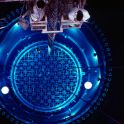
Research on operation of research reactors
Research reactors are used for the most diverse applications. The spectrum ranges from the study of fundamental physical phenomena to investigations in the field of materials science and the production of radioisotopes for nuclear medicine. In contrast to commercial power reactors, however, research reactors do not generate electricity. Currently, there are six research reactors in operation in Germany: The Research Neutron Source FRM II of Munich Technical University, the TRIGA Mark II research reactor of Mainz University, and the four training reactors SUR Stuttgart, SUR Ulm, SUR Furtwangen and AKR-2 Dresden.
Research reactors differ from power reactors in design, construction, the materials used, and the operational loads. They have a thermal power which is lower by several orders of magnitude and thus have a considerably lower risk potential than power reactors. GRS scientists are studying how these differences affect the safety of research reactors. In a current research project, they focus on the ageing behaviour and the reactor internals which are typical of research reactors: the so-called experimental facilities.
Systematically processing and evaluating knowledge about experimental facilities
Experimental facilities are the internals in which the research takes place. These include e.g. irradiation devices in which the samples to be analysed are exposed to neutron radiation, or so-called "cold sources" with which the neutrons from the reactor core are "slowed down".
"We cannot simply apply the findings from research on power reactors to research reactors. The differences are too big for that", says Dr. Marcus Trapp, leader of the project "It is above all the experimental facilities in the reactor core and its vicinity that are stressed by the locally high neutron fluxes and - compared to power reactors - the higher number of operating cycles ".
In the research project, the experts of GRS prepare in a first step an overview of all types of experimental facilities used in research reactors. The documented operating experience is also included in this process. In a second step, the GRS experts evaluate the regulatory provisions and licensing processes of the experimental facilities. A third step comprises the classification of the experimental facilities with regard to their safety significance. In a fourth and final step, the experts investigate how postulated faulty or erroneously operated experimental facilities affect the overall facility or the environment of a research reactor. For this purpose, the scientists make use of the ATHLET software developed by GRS with which the processes in the reactor can be simulated.
Analysing the ageing behaviour of structures, systems and components in research reactors
According to the International Atomic Energy Agency (IAEA), over 40% of the 224 research reactors in operation worldwide are currently over 50 years old. Four of the six German research reactors were commissioned in the 1960s and 1970s. Against this background, the GRS project also deals with the ageing of structures, systems and components in research reactors. "In this context, we particularly look at safety-relevant equipment that differs significantly from power reactors with regard to the materials used, design, and operating conditions," says Trapp.
Examples are mechanical components manufactured from metallic alloys that are not used in the construction of power reactors. Targeted investigations are also performed on experimental facilities whose use is planned over longer periods of time and which may have an influence on safety equipment.
In this context, the design, loading and ageing phenomena of structures, systems and components in research reactors are recorded. Here, the focus is on the differences to power reactors, such as special alloys and the operating conditions of the equipment. Based on this, representative facilities are selected and their ageing behaviour and measures for the monitoring and control of ageing phenomena are studied in more detail. GRS then adds the results to its knowledge base on the ageing behaviour of structures, systems and components.
Safety of research reactors as an international concern
Various international institutions are also currently dealing with the safety of research reactors. For example, the International Atomic Energy Agency (IAEA) is currently revising its relevant guidelines. The Western European Nuclear Regulators Association (WENRA) - an association of European nuclear regulatory authorities - is working on establishing so-called Safety Reference Levels for research reactors. Safety Reference Levels describe fundamental and transnational requirements for the safety of reactors. These activities are systematically monitored by GRS and evaluated for the current project.
Project highlights Reactor Safety

Researchers worldwide are working on small modular reactors (SMR) and microreactors (very small modular reactor, vSMR). Many of these new reactor concepts are being developed for specific applications and have special core geometries. In order to be able to simulate the neutron-physical behaviour of these cores, GRS is developing the simulation code FENNECS (Finite ElemeNt NEutroniCS).